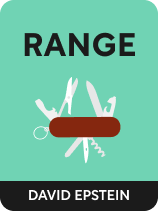

This article is an excerpt from the Shortform book guide to "Range" by David J. Epstein. Shortform has the world's best summaries and analyses of books you should be reading.
Like this article? Sign up for a free trial here .
What is lateral thinking? Can you really come up with great ideas based on old knowledge or technology?
In his book Range, David Epstein discusses the importance of lateral thinking in innovation. He says that contrary to popular belief, you don’t need to think outside the box and come up with brand new ideas to be innovative—sometimes it just takes looking at an existing product and improving upon it.
Keep reading for examples of lateral thinking from David Epstein.
Lateral Thinking Yields New Ideas
What is lateral thinking? In contrast with “forward thinking,” “lateral thinking” refers to any use of pre-existing knowledge in a new context. Specialists assume that new, undiscovered knowledge and technology is the key to innovation, but Epstein argues that this isn’t necessarily the case. Often, old ideas used in a new way are more valuable than cutting-edge discoveries. For example, the construction workers who popularized duct tape were simply repurposing an older tape they had used to seal ammunition boxes during World War II.
Lateral thinking is much more difficult to cultivate than specialized efficiency. Epstein argues that specialization is sometimes a shortcut around the need for fresh ideas—for instance, when video game companies compete for better graphics instead of more engaging gameplay. However, the evidence shows you can’t buy innovation—a study of private Research and Development teams (who are hired solely to innovate) found no correlation between funding and performance.
Instead, the key to lateral thinking is to get rid of perceived constraints on ideas—back away from the cutting edge and draw from a broader range of experience.
| Creativity Requires Inefficiency This intentional distance from the cutting edge is one of many counterintuitive strategies that have proven to be successful at fostering creativity and innovation. Often, the management strategies that yield the most creative ideas are the opposite of those required for efficient procedural work. Robert Sutton, the author of Weird Ideas That Work, concludes that the most innovative organizations are “inefficient (and often annoying) places to work.”Sutton offers another piece of counterintuitive advice: Managers of creative teams should reward employees for success and failure and only punish employees for inaction. Quantity, not quality, is the path to creative success. Here’s another: Companies that want innovation should hire employees that often refuse to listen to bosses or coworkers. The Xerox employee who invented the laser printer was someone like this. He was working at a research and development lab, an organization whose sole purpose is innovation, yet when he suggested they look into the blossoming new potential of laser technology, he was dismissed by his coworkers and ordered to stop looking into it by his boss. Fortunately, he complained to someone higher up, got transferred to a new lab, and revolutionized the printing industry. |
Lateral Thinking From Non-Experts
Epstein writes extensively about cases in which outsiders with less expertise and less information about a given situation solve problems that have stumped teams of experts for years. This speaks to the value of lateral thinking—sometimes, specialists are simply looking for answers in the wrong places.
Epstein describes a company called InnoCentive that allows organizations to post descriptions of problems and challenges they’re facing and crowdsource solutions from strangers on the Internet. Examples of problems solved by InnoCentive users include NASA’s inability to predict solar particle storms and the Oil Spill Recovery Institute’s struggle to clean oil out of their recovery barges.
One advantage unique to amateurs is not knowing enough to believe that an idea is ridiculous. For example, NASA employees scoffed at the idea to predict particle storms with telescopes built to detect radio waves—until it worked.
| When Crowdsourcing Goes Wrong Crowdsourcing like InnoCentive has become a popular problem-solving strategy in recent years. However, research has shown that it’s only successful when it’s designed in a specific way. Crowdsourcing works best when it’s directed at a single solvable problem and only attracts the right kind of people. Netflix’s 2006 “Netflix Prize” is a prime example: The company offered to pay $1 million to whatever team could improve their suggestion algorithm by 10%. The nature of the technical problem ensured that those posing solutions had at least some degree of expertise, and the quantitative nature of the solution made it easy for Netflix to sort out ineffective solutions. Compare this to the crowdsourcing disaster of the BP oil spill. More than a hundred experts at BP were forced to sort through 123,000 potential solutions purporting to help clean up the millions of barrels of oil in the Gulf of Mexico. Out of these, only 470 were deemed potentially useful, and just 30 were put to use, most of which were minor improvements on existing techniques. Overall, it was declared a waste of time, due to the fact that the proposals attracted ineffective problem solvers and couldn’t be easily filtered. |
It’s important to note that a team entirely comprised of outsiders wouldn’t succeed. Epstein admits that most groups require a certain amount of specialization. Researchers studying engineers have found that specialists and generalists are evenly matched in terms of innovation. Specialists are better at solving difficult technical issues, and generalists are better at lateral thinking.
The most innovative team members, however, are polymaths—whom Epstein defines as those who possess both broad knowledge in many areas and heavily specialized knowledge in at least one area. Polymaths represent the best of both worlds. They’re generalist enough to generate unique ideas and specialized enough to implement those ideas at a high level.
| It’s easier than ever before to become a polymath and find success, for a number of reasons. The Internet has proven to be an invaluable resource for people who want to educate themselves to a professional level. When Michael Sayman was 13, he learned how to code online and released an app that became one of the top 100 in the world. Additionally, as human knowledge expands into more and more domains, the number of unique potential combinations of knowledge between those domains grows exponentially. This increases your chances of mastering a skill set that no one else in the world has—“quantum biology,” for example, only rose to prominence in the last couple of decades. |

———End of Preview———
Like what you just read? Read the rest of the world's best book summary and analysis of David J. Epstein's "Range" at Shortform .
Here's what you'll find in our full Range summary :
- Why it's better to be proficient in a range of skills rather than becoming a specialist in one
- Why you're never “too late” to pursue something you’re interested in
- Why the nontraditional background of a generalist gives them an edge






